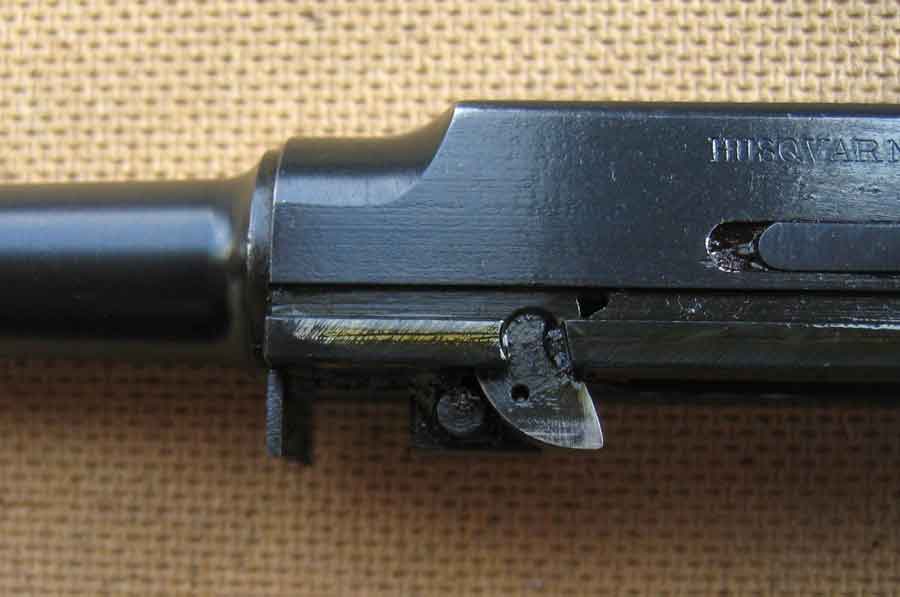
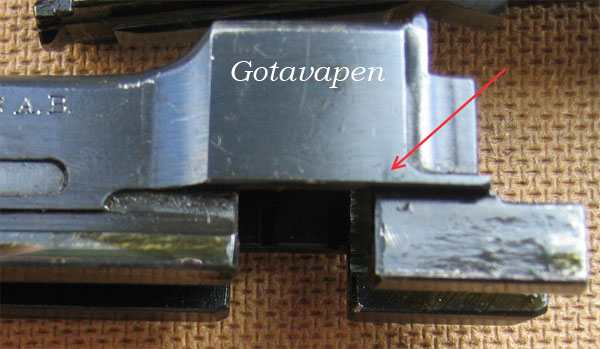
Another vulnerable point in the slide is at the cut for the bolt lock.
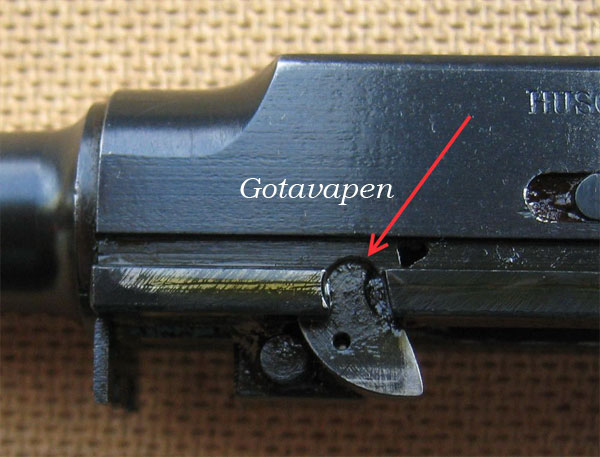
Swedish
Pistol m/1940
made by Husqvarna Gun Factory
Text by O. Janson
updated 2017-10-30
| Page 1 | |
|
Page 2 |
|
| Page 3 | Different magazines and equipment for m/40. |
| Page 4 | |
| Page 5 | |
| Page 6 |
Page 2/6
Different slides.
|
Different slides. During the war there was a lack of steel with nickel. The small amount of this steel Husqvarna could have access to was used for the barrels, while the slides and frames were made from steel with molybdenum. After extensive firing there appeared cracks in the slide, which had to be changed. There are basically four different variations of slides. Three "Husqvarna Vapenfabriks AB" marked slides differ as follows: 1st slide variation:
2nd slide variation:
3rd slide
variation:
There is a 4th stronger variation of the slide which was made at Carl Gustaf GF 1960. The
CG slide is much heavier and without the Husqvarna name on the left side of
the slide but is otherwise similar to the HVA 3rd variation. |
 |
|
| Here is the accelerator for the slide. This is a 2nd slide variation with three wholes drilled to at the accelerator. | |
 |
WARNING!
If you
have one of these
pistols
-
be aware of cracks in
your
slide
on this point. Another vulnerable point in the slide is at the cut for the bolt lock. |
|
|
|
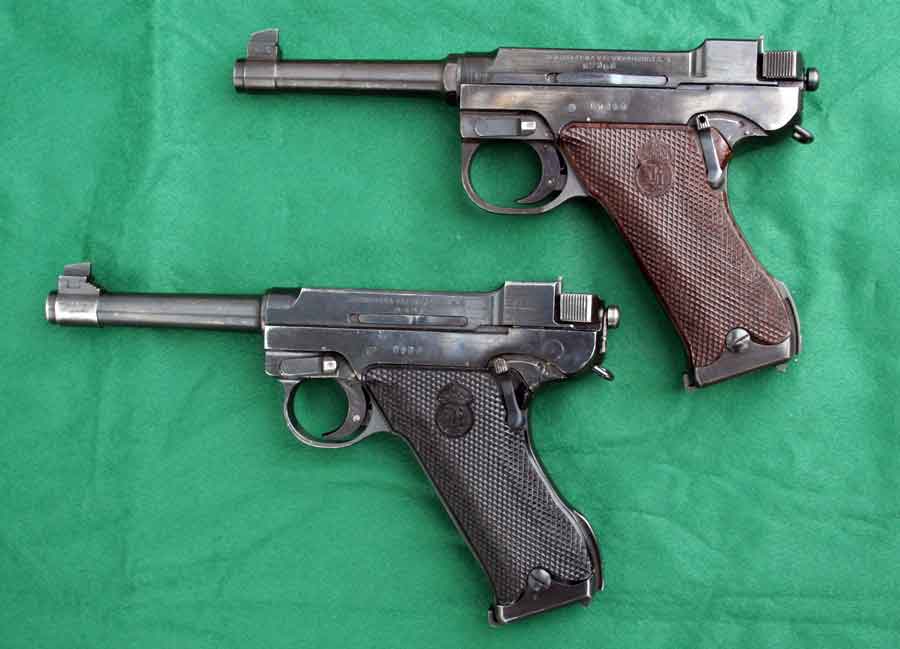 |
|
On top a late pistol m/40 with "slide 3" and red side-plates. Note the square foot for the front sight and an outer nut on the barrel at the breech. The frame has a wide trigger-guard for gloves. At the bottom the old type of pistol m/40 with "slide 2" and black old type side-plates. The front sight base has steps. Barrel is the old type smooth standard type without nut. |
 |
This is the very first variation with old type of barrel and old type of slide. The front sight base has steps.
Heavy slide 4th type. This is a late m/40 of H-series made for the civilian market with new type heavy slide. Note the square foot for the front sight and an outer nut on the barrel at the breech. The frame has a narrow trigger-guard, maybe because it was made for the civilian market. |
|
Several other modifications were also made beside the very first made as mentioned above. The most apparent was a change of the barrel to a barrel with square foot for the front sight and an outer nut at the breech to make it easier to change the barrels. The trigger guard was enlarged to make it possible for soldiers to use gloves when firing the gun. Bolt head
– 17.8 mm high, then it was made less high. The carrier for the recoil pin in the end of the frame is 9 mm wide later it was changed to 13.5 mm width. Firing
pin – old type in one piece Normally you find HVA m/40 with red side plates. The first pistols were made with black side plates of bakelite later with red due to lack of components during the war. |
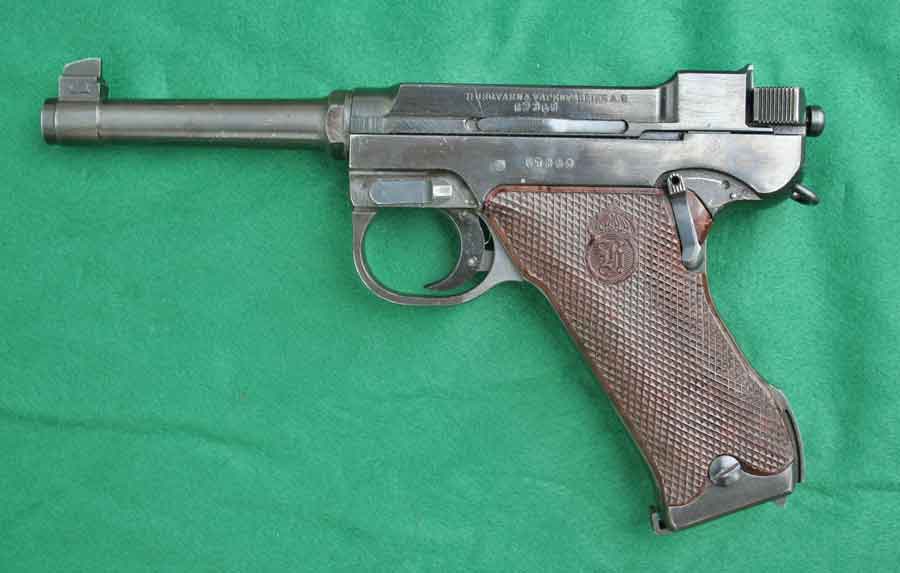 |
|
Here is a good example of a late pistol m/1940 with third type of slide |
Pistol m/40 made from Spare partsDuring 1973 and 1974 the Danish gun dealer V. Pabst & Co in Helsingor sold a major lot of the surplus Danish Military pistols m/40S. Along with this lot followed many spare-parts. The company assembled about 50 guns from these parts. The spare-parts had no serial numbers. For this reason they were stamped with VP 1-19 and VP 100 and VP101. The remaining spare-part pistols were bought by a Swiss company Paul Schafrodt and these are marked PS 1-20. Some of these pistols are marked "Made in Sweden" and "Sweden". This has nothing to do with the original Military pistols or manufacturer. Additional marks and stampsBelow the barrel on Swedish Military weapons, including pistol m/40, you can find triangular marks – stamped: One up to three triangles. These are inspection officer’s marks. Before the gun is issued from the store it is inspected for rust and wear. · 1 triangle = small amount of rust & wear · 2 triangles = acceptable amount of rust & wear · 3 triangles = poor barrel which will be destroyed next time.
Twin mark of mandrel. At the rear end of the grip high up there might be two marks after a mandrel. This indicates that the pistol has been refurbished at a Military service station. Maybe the slide was changed or the barrel. This type of twin mark appears on both pistols m/40 and m/07. These pistols have a reputation to crack in the slide. All Military m/40 pistols were melted down in Sweden On the 23rd of January 1991 there was an accident with a blown up pistol m/40 in the Swedish Army, which resulted in physical damage to a soldier. Since that time these pistols have been banned and now, according to a General Order, all of them destroyed. These Swedish pistols were never sold as surplus.
|
| Index for the homepage of Pistol m/1940. | |
| Page 1 | |
|
Page 2 |
|
| Page 3 | Different magazines and equipment for m/40. |
| Page 4 | |
| Page 5 | |
| Page 6 | |
|
References: Jimmy Johansson |
|
|
Gothia Arms Historical Society in English |
 |
Pistol m/1907 |
|
|
Gothia Arms Historical Society in Swedish |
 |
Overview of all Swedish Military pistols and revolvers |